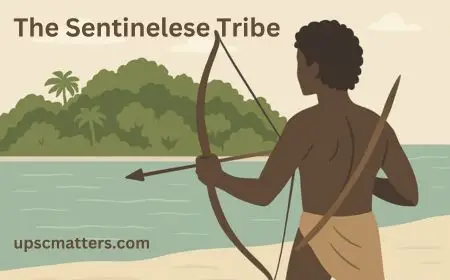The North Sentinel Island, located in the Andaman and Nicobar Islands of India, has recently been in the news due to its mysterious inhabitants—the Sentinelese Tribe, one of the few remaining uncontacted tribes in the world. Protected by strict laws and classified as a Particularly Vulnerable Tribal Group (PVTG), the Sentinelese Tribe’s represent a unique case of cultural isolation, indigenous rights, and tribal autonomy.
This article presents a complete overview of the Sentinel Islands—covering their geographical significance, legal framework, ethical dilemmas, and strategic relevance—making it highly relevant for the UPSC Civil Services Examination (Prelims & Mains GS-I, GS-III, and Essay Paper). Read on for concise, point-wise notes tailored for serious aspirants.
Recent Developments
- Arrest of US Tourist (March 2025): Mykhailo Viktorovych Polyakov, a 24-year-old American, was arrested for illegally landing on North Sentinel Island. He used an inflatable boat, left a coconut and Diet Coke as “offerings,” and recorded his visit via GoPro. This was his third attempt after being stopped in 2024 and January 2025.
- Threats from Social Media Influencers: Survival International warned that influencers seeking “thrills” endanger isolated tribes by exposing them to diseases and disrupting their way of life.
- Historical Precedent (2018): American missionary John Allen Chau was killed by the Sentinelese after attempting to convert them. His body was never recovered due to legal restrictions on approaching the island.
Introduction to North Sentinel Island
- The Sentinel Islands, especially North Sentinel Island, are part of the Andaman and Nicobar Islands in the Bay of Bengal.
- They are globally known for being home to the Sentinelese, one of the last uncontacted tribes in the world.
- The island remains in the news due to debates around tribal rights, isolation, anthropological interest, and state policy.
Geography and Demography of North Sentinel Island
- Location: Part of India’s Andaman and Nicobar archipelago in the Bay of Bengal, specifically, under the jurisdiction of the South Andaman administrative district.
- Size: ~60 km² (size of Manhattan), surrounded by coral reefs and dense forests.
- Tribal Population: Sentinelese are a Particularly Vulnerable Tribal Group (PVTG). Estimates range from 50–200 individuals. They are hunter-gatherers with no immunity to modern diseases.
The Sentinelese Tribe’s
- One of the most isolated tribes in the world.
- Believed to have lived on the island for over 50,000 years.
- They belong to the Negrito racial group.
- The tribe practices hunting and gathering, and uses bows, arrows, and spears.
- Known for their hostility to outsiders—visitors are often met with violence.
Legal Framework and Protections for North Sentinel Island
- Andaman and Nicobar Islands (Protection of Aboriginal Tribes) Regulation, 1956: Prohibits entry within 5 nautical miles (9.26 km) of the island to protect the tribe from diseases and cultural disruption.
- 2012 Amendment: Strengthened penalties for violations, including up to 8 years imprisonment.
- Forest Rights Act, 2006
- Article 29 and 342 of the Indian Constitution ensure protection of their distinct culture and status as a Scheduled Tribe.
- Strategic Importance: India plans a $9 billion military upgrade in the Andamans to counter Chinese influence in key shipping lanes.
Risks of Contact with Sentinelese Tribe’s
- Health Threats: Diseases like flu or measles could decimate the tribe due to lack of immunity. Past examples include the Nahua tribe in Peru, where 50% died post-contact.
- Cultural Preservation: The Sentinelese have rejected outsiders for millennia. Anthropologist Triloknath Pandit noted their hostility stems from self-preservation, not aggression.
- Ethical Concerns: NGOs like Survival International argue forced contact violates tribal autonomy and international laws like the UN Declaration on Indigenous Peoples.
Government’s Policy
- “Hands-off” policy: India has adopted a non-interventionist approach to protect the tribe.
- No attempts to assimilate or integrate them into modern society.
- Focus is on:
- Monitoring from a distance.
- Avoiding any contact.
- Ensuring their ecosystem is undisturbed.
Significance from UPSC Perspective
(a) Ecological & Cultural Significance
- Sentinelese culture provides insight into pre-Neolithic societies.
- Preservation contributes to human heritage.
(b) Anthropological Significance– Rich subject for ethnographic studies, though research is limited due to ethical constraints.
(c) Security Concerns
- Potential threat due to illicit fishing and poaching around the island.
- Proximity to international sea routes raises strategic concerns.
(d) Policy Challenges– Balancing human rights, tribal autonomy, national security, and development is a constant dilemma.
Key Facts for Prelims
| Aspect | Detail |
| Island Name | North Sentinel Island |
| Tribe Name | Sentinelese |
| Location | Bay of Bengal, South Andaman District |
| Legal Protection | A&N Regulation, FRA 2006, Constitution Articles |
| Entry Prohibition Zone | 5-nautical miles |
| Tribe Status | Particularly Vulnerable Tribal Group (PVTG) |
| Language | Unknown; no deciphered script |
| Lifestyle | Hunter-gatherer |
Way Forward
- Continue hands-off policy unless there’s an existential threat.
- Strict enforcement of entry prohibitions.
- Encourage academic debate but restrain direct anthropological intervention.
- Use satellite surveillance for security & health monitoring without intrusion.
Key Takeaways for UPSC Mains
- Ethics vs. Exploration:
- Balancing adventure tourism with tribal rights.
- Should state intervene when a tribe refuses modern healthcare or education?
- Legal Enforcement:
- Can non-contact be considered a violation of the Right to Life (Article 21), or a protection of it?
- Right to life and development vs. right to self-determination.
- Global Precedents: Lessons from Brazil’s Amazon tribes and Peru’s Nahua tribe.
- Strategic Policy: India’s dual focus on tribal welfare and military expansion in the Andamans.
If you found this helpful, you might also like these articles:
📌 [ https://upscmatters.com/pink-fire-retardants-in-wildfire-management-upsc/]
📌 [ https://upscmatters.com/india-ranked-118th-in-world-happiness-index-2025/]
They cover key concepts that will boost your preparation! 🚀
📢 Stay Updated with the Best UPSC Resources!
Join our Telegram Channel for:
✅ Daily Current Affairs
✅ Important Notes & PDFs
✅ Answer Writing Tips
✅ Strategy & Motivation
📲 Click the link to join now: [https://t.me/upscmatters] or [https://t.me/ramsirnotes]
Don’t miss out on valuable updates! 🚀

